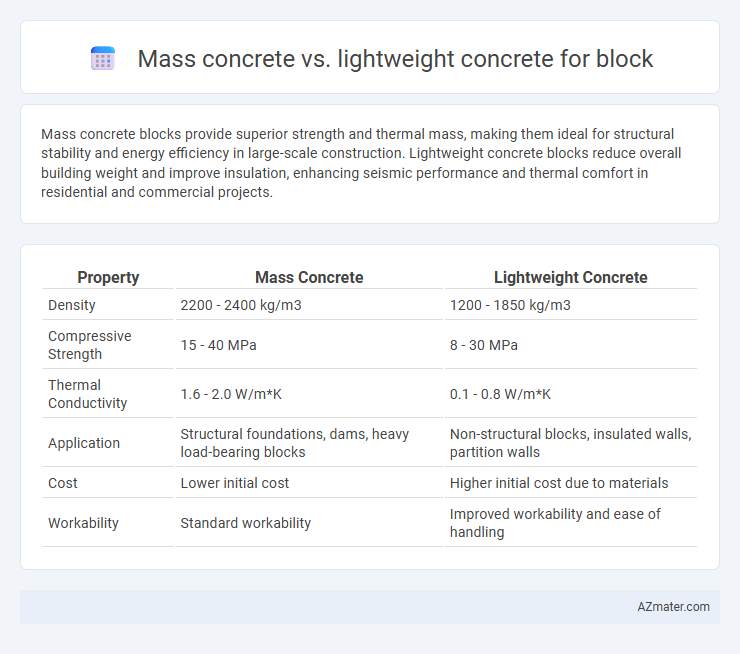Mass concrete blocks provide superior strength and thermal mass, making them ideal for structural stability and energy efficiency in large-scale construction. Lightweight concrete blocks reduce overall building weight and improve insulation, enhancing seismic performance and thermal comfort in residential and commercial projects.
Table of Comparison
| Property | Mass Concrete | Lightweight Concrete |
|---|---|---|
| Density | 2200 - 2400 kg/m3 | 1200 - 1850 kg/m3 |
| Compressive Strength | 15 - 40 MPa | 8 - 30 MPa |
| Thermal Conductivity | 1.6 - 2.0 W/m*K | 0.1 - 0.8 W/m*K |
| Application | Structural foundations, dams, heavy load-bearing blocks | Non-structural blocks, insulated walls, partition walls |
| Cost | Lower initial cost | Higher initial cost due to materials |
| Workability | Standard workability | Improved workability and ease of handling |
Introduction to Mass Concrete and Lightweight Concrete
Mass concrete refers to large-volume concrete structures where thermal control is critical due to heat generated during cement hydration, commonly used in dams and foundations. Lightweight concrete incorporates lightweight aggregates such as expanded clay or pumice, significantly reducing density while maintaining adequate strength for block construction. These properties influence block performance, with mass concrete blocks offering high durability and load-bearing capacity, and lightweight concrete blocks providing enhanced thermal insulation and easier handling.
Key Differences Between Mass Concrete and Lightweight Concrete
Mass concrete is characterized by its high density and compressive strength, typically exceeding 2400 kg/m3, making it suitable for heavy structural applications like foundations and dams. Lightweight concrete, with densities ranging from 1600 to 1900 kg/m3, incorporates lightweight aggregates such as expanded clay or pumice to reduce weight, improve thermal insulation, and enhance fire resistance. The key differences lie in their density, thermal conductivity, and structural applications, where mass concrete provides superior load-bearing capacity while lightweight concrete offers energy efficiency and reduced structural load.
Composition and Material Properties
Mass concrete typically consists of a dense mixture of cement, aggregates including gravel and sand, and water, resulting in high compressive strength and durability ideal for heavy structural applications. Lightweight concrete incorporates lightweight aggregates such as expanded clay, shale, or pumice, which reduce density and improve thermal insulation while maintaining adequate strength for block construction. The material properties of mass concrete include higher density and thermal mass, whereas lightweight concrete offers enhanced thermal insulation, reduced dead load, and increased fire resistance.
Structural Performance in Block Applications
Mass concrete blocks exhibit higher compressive strength and superior load-bearing capacity, making them ideal for structural wall applications requiring durability and stability. Lightweight concrete blocks reduce dead load, enhancing seismic performance and enabling easier handling during construction without significantly compromising structural integrity. Both materials offer distinct advantages, with mass concrete prioritizing strength and lightweight concrete optimizing structural efficiency in block applications.
Thermal Insulation and Energy Efficiency
Mass concrete blocks exhibit high thermal mass, absorbing and slowly releasing heat, which stabilizes indoor temperatures but offers limited insulation against temperature extremes. Lightweight concrete blocks contain air pockets that significantly reduce thermal conductivity, improving thermal insulation and reducing heating and cooling energy demands in buildings. This enhanced energy efficiency in lightweight concrete blocks contributes to lower utility costs and improved occupant comfort compared to traditional mass concrete blocks.
Workability and Construction Methods
Mass concrete offers high density and strength but tends to have lower workability, often requiring more vibration and compaction to eliminate voids during construction. Lightweight concrete, containing air-entrained aggregates or foam, improves workability with easier mixing and placing, reducing the need for intensive vibration. Construction methods for mass concrete rely on controlled pouring and curing to manage heat and shrinkage, while lightweight concrete enables faster placement and better handling due to its reduced weight and enhanced flow characteristics.
Durability and Longevity
Mass concrete offers superior durability due to its high density and low permeability, making it highly resistant to weathering, chemical attacks, and mechanical wear over time. Lightweight concrete, with its lower density and higher porosity, generally exhibits reduced durability and may be more susceptible to moisture ingress and freeze-thaw cycles, potentially shortening its service life. For blocks requiring extended longevity and structural robustness, mass concrete is typically preferred over lightweight concrete.
Cost Comparison and Economic Impact
Mass concrete generally incurs lower initial material costs due to its use of locally available aggregates, making it economically favorable for large-scale block production. Lightweight concrete blocks demand higher expenditure on specialized lightweight aggregates and processing, impacting upfront investment but offering long-term savings through reduced transportation and structural support costs. Evaluating life-cycle costs reveals that while mass concrete is cost-effective initially, lightweight concrete can deliver better economic benefits in projects prioritizing energy efficiency and load reduction.
Environmental Considerations and Sustainability
Mass concrete blocks typically have higher embodied energy and carbon footprints due to their dense composition and cement content, raising concerns about sustainability. Lightweight concrete blocks incorporate materials such as expanded clay, fly ash, or recycled aggregates, reducing overall weight and improving thermal insulation, which enhances energy efficiency in buildings. The use of industrial byproducts and better insulation properties in lightweight concrete contributes to lower environmental impact and supports sustainable construction practices.
Choosing the Right Concrete Type for Block Construction
Mass concrete offers superior strength and durability for block construction, ideal for structural elements requiring high load-bearing capacity. Lightweight concrete enhances thermal insulation and reduces overall structure weight, making it suitable for energy-efficient buildings and ease of handling. Selecting between mass and lightweight concrete depends on project-specific requirements such as load demands, thermal performance, and construction speed.

Infographic: Mass concrete vs Lightweight concrete for Block
 azmater.com
azmater.com